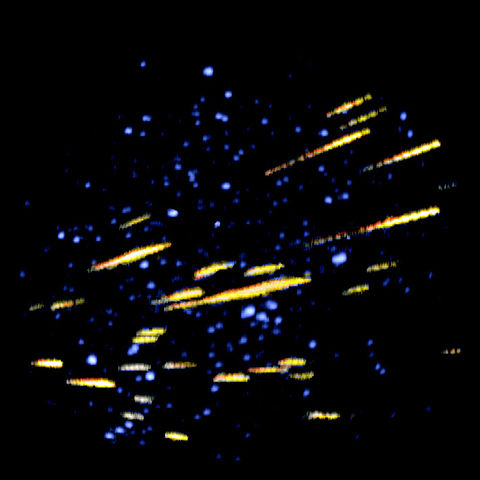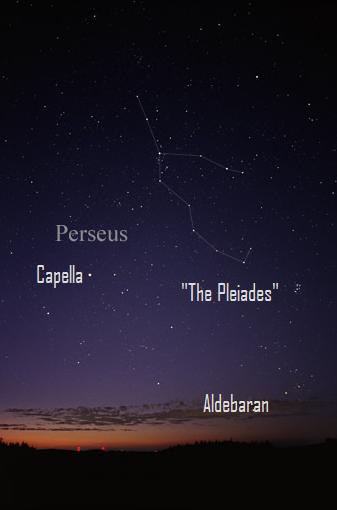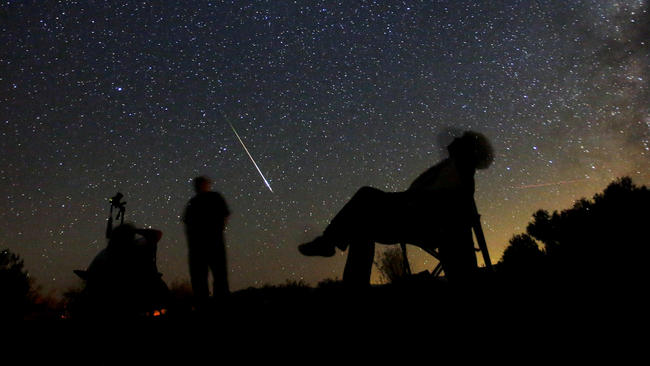Meteor Showers – The Perseids
 You have probably heard of a shooting or falling star, but have you ever seen one? If you have ever spent any amount of time looking up at the night sky, then you probably have – a flash of light streaking high above through the darkness for just a moment, disappearing just as quickly as it appeared – sometimes so quick that you cannot be sure if you have really seen something or imagined it. You might think that your eyes are playing tricks on you, but shooting stars are definitely real! Your parents may have told you to quickly make a wish on a shooting star before it vanishes – what will your next wish be when you get to see one?
You have probably heard of a shooting or falling star, but have you ever seen one? If you have ever spent any amount of time looking up at the night sky, then you probably have – a flash of light streaking high above through the darkness for just a moment, disappearing just as quickly as it appeared – sometimes so quick that you cannot be sure if you have really seen something or imagined it. You might think that your eyes are playing tricks on you, but shooting stars are definitely real! Your parents may have told you to quickly make a wish on a shooting star before it vanishes – what will your next wish be when you get to see one?
Here’s another question for you, a little bit harder this time: do you know what a shooting star is? Their names are a little misleading and this causes some people to think that these fast moving trails of light really are stars that have fallen out of the sky. However, this is not true. Our Sun is a star, our closest star, and the other stars are many many miles away (it would take more than your lifetime to travel to them!) and since they are much bigger than a shooting star, they are certainly not responsible, so we can count them out. If you are still not sure of the answer, then you might be surprised to learn that shooting stars are just tiny bits of dust entering the Earth’s atmosphere from space. Tiny particles, like grains of sand or pebbles on a beach, like to crash into the atmosphere at amazingly fast speeds – some faster than a car travelling at his highest speed along the motorway!
Occasionally, however, the piece of rock can be big enough so that it does not all burn up while entering the atmosphere and it will hit the ground. We call these meteorites (while they are flying through the atmosphere as shooting stars we call them meteors, and while they are in space we call them meteoroids – it is important to remember the difference!). A whopping 38,000 meteorites have been found on Earth so far, from all over the world, but most are found in the hot desert or in freezing cold Antarctica.
Comets and asteroids are leftover debris from the when the planets were being built in the Solar System. Just like asteroids, comets make falling stars, but rather than seeing one of them every so often (that are easy to miss!), there is a shower of them – astronomers call these meteor showers and they are made when the Earth moves through the tail of a comet that has been left behind after one of these icy and dusty bodies have swooped past us. You can usually see at least a few meteors during a shower, but on a particularly good show, you can sometimes see hundreds of shooting stars per hour – you can be sure not to miss one then! The best meteor showers are the Quadrantids that are at their best on the 3rd January every year, the Lyrids that are at their best on 22nd April, the famous Perseids on 12th August, the Orionids on 22nd October, the Leonids on 17th November and the Geminids on 14th December. The Geminids, it is thought, are actually dust from an asteroid called Phaethon rather than a comet – and it has been shown that Phaethon was originally part of the second biggest asteroid Pallas, but was smashed off in a mighty collision with another asteroid billions of years ago. Meteor showers are named after the constellation that they appear to be falling from. For example, the Geminids will be shooting away from the constellation, Gemini (The Twins), whereas the Perseids are from Perseus (The Hero). Why don’t you grab a map of the constellations and, with your friends, see if you can find them in the night sky before the meteor showers start?
The Perseid meteor shower is perhaps the most beloved meteor shower of the year for the Northern Hemisphere. The rather bright waxing gibbous moon staying out until after midnight will obtrude on this year’s shower, especially in the evening hours. Your best bet is to watch after moonset and before dawn August 12. The Perseid shower builds gradually to a peak, often produces 50 to 100 meteors per hour in a dark sky at the peak, and, for us in the Northern Hemisphere, this shower comes when the weather is warm. The Perseids tend to strengthen in number as late night deepens into midnight, and typically produce the most meteors in the wee hours before dawn. They radiate from a point in the constellation Perseus the Hero, but, as with all meteor shower radiant points, you don’t need to know Perseus to watch the shower; instead, the meteors appear in all parts of the sky. They are typically fast and bright meteors. They frequently leave persistent trains. Every year, you can look for the Perseids to peak around August 10-13. Predicted peak morning in 2016: August 12. The Perseids combine with the Delta Aquarid shower (above) to produce a dazzling display of shooting stars on what are, for us in the N. Hemisphere, warm summer nights. In 2016, as always, the Perseid meteors will be building to a peak from early August until  the peak nights; afterwards, they drop off fairly rapidly. Despite the waxing gibbous moon interfering with the show, the Perseid meteor shower should still put on a good show. For maximum results, watch after moonset and before dawn August 11, 12 and 13. Don’t wait until the peak nights of the 2016 Perseid shower to watch for meteors this year. Start watching in the second week of August, when the Delta Aquarid meteor shower is rambling along steadily, reliably producing meteors each night. Then keep watching in the second week of August, when the Perseids are rising to a peak. The Perseid shower is known to rise gradually to a peak, then fall off rapidly afterwards. In early August (and even through the peak nights), you’ll see them combine with meteors from the Delta Aquarid shower. Overall, the meteors will be increasing in number from early August onward, and better yet, but the moonlight will increase as it waxes past first quarter on August 10, 2016.
the peak nights; afterwards, they drop off fairly rapidly. Despite the waxing gibbous moon interfering with the show, the Perseid meteor shower should still put on a good show. For maximum results, watch after moonset and before dawn August 11, 12 and 13. Don’t wait until the peak nights of the 2016 Perseid shower to watch for meteors this year. Start watching in the second week of August, when the Delta Aquarid meteor shower is rambling along steadily, reliably producing meteors each night. Then keep watching in the second week of August, when the Perseids are rising to a peak. The Perseid shower is known to rise gradually to a peak, then fall off rapidly afterwards. In early August (and even through the peak nights), you’ll see them combine with meteors from the Delta Aquarid shower. Overall, the meteors will be increasing in number from early August onward, and better yet, but the moonlight will increase as it waxes past first quarter on August 10, 2016.
Watching a meteor shower can be one of the most enjoyable things about observing the night sky, waiting with tense excitement to see the next shooting star. The best meteor shower is the Perseids – not just because it has the most meteors (although it does have as many as 100 per hour) – but because you can sit out in the garden during the warm summer night to watch them, rather than having to wrap up in your scarf, bobble hat and wooly mittens during the middle of winter, as you would have to for watching the Geminids in December!
The brightest meteors can be seen even from the city, but the darker your skies, the more meteors you will see. Try to keep away from street lights and outside house lights. Remember too, that if the moon is in the sky and is anywhere from half to full, it will also cause light problems so that fainter meteors will not be seen. For the best meteor viewing, it is best to find a dark corner of your garden or from wherever you are observing them. Give time for your eyes to get used to the darkness, and use a red light flashlight rather than a normal flashlight, so that you do not ruin your night vision when looking at maps of the night sky. If you do not have a red light flashlight, then you can just cellotape some red see-through paper over a normal flashlight – it works just as well! To avoid going back inside, bring a water bottle and some snacks out into the garden with you. Make sure that you wrap up warm – even in August for the Perseids, it can still get chilly late at night. Remember that a hat is essential, as your body loses much of its heat through your head.
Now, you have probably found that when looking at the stars that straining your neck to look up all the time can quickly become uncomfortable. For meteor watching, a deck chair is ideal – you are angled comfortably so you do not have to strain your neck.
The meteorites you see during a meteor shower might appear to be very close, but did you know that those tiny particles of burning space debris are actually about 30 to 40 miles (48 to 64km) above Earth’s surface? Pretty amazing that you are able to see such a tiny piece of space dust from so far away!









